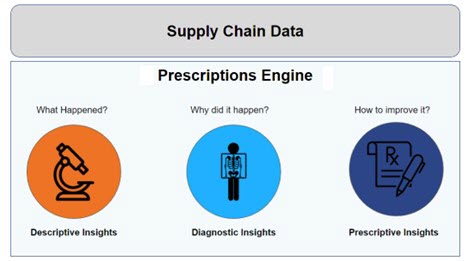Supply Chain Prescriptions background
The Supply Chain Prescriptions app analyzes a supply chain’s data and provides descriptive, diagnostic, and prescriptive insights based on that data. This data is made available through a Supply Chain model.

Cost background
Supply Chain Prescriptions uses an algorithmic framework with cost as an objective function to generate the following transportation-based prescriptions that proactively identify potential savings in the supply chain:
-
mode switching
-
node skipping
-
volume consolidation
User-defined parameters, such as invalid modes, shipment frequencies, and mode thresholds, can also be incorporated to enhance the effectiveness of the app. Input, output, and configuration data is all stored in the Supply Chain database.
Risk background
The Cost workflow helps in identifying potential cost saving opportunities by either skipping a node, switching a mode, or consolidating shipments. The Risk workflow helps to design robust networks in order to mitigate effects of potential ydisruptions in supply chain networks at critical sites for critical products.
The Prescriptions workflow for Risk identifies critical products and critical sites by revenue and generates constraints that need to be imposed on the network to minimize the risk of those critical sites. The constraints correspond to various levels of risk.
These generated constraints are compiled into an optimized scenario that provides the final set of flow prescriptions to the user. In order to eliminate the infeasibility of scenarios due to the additional constraints, these additional constraints on flows are introduced as soft constraints, where the objective function is a summation of the Total Cost / Total Profit and the penalties that are introduced for any violation of flow constraints in the scenario.
Last modified: Thursday June 22, 2023
